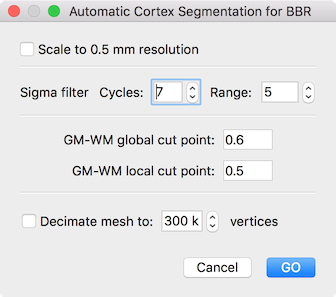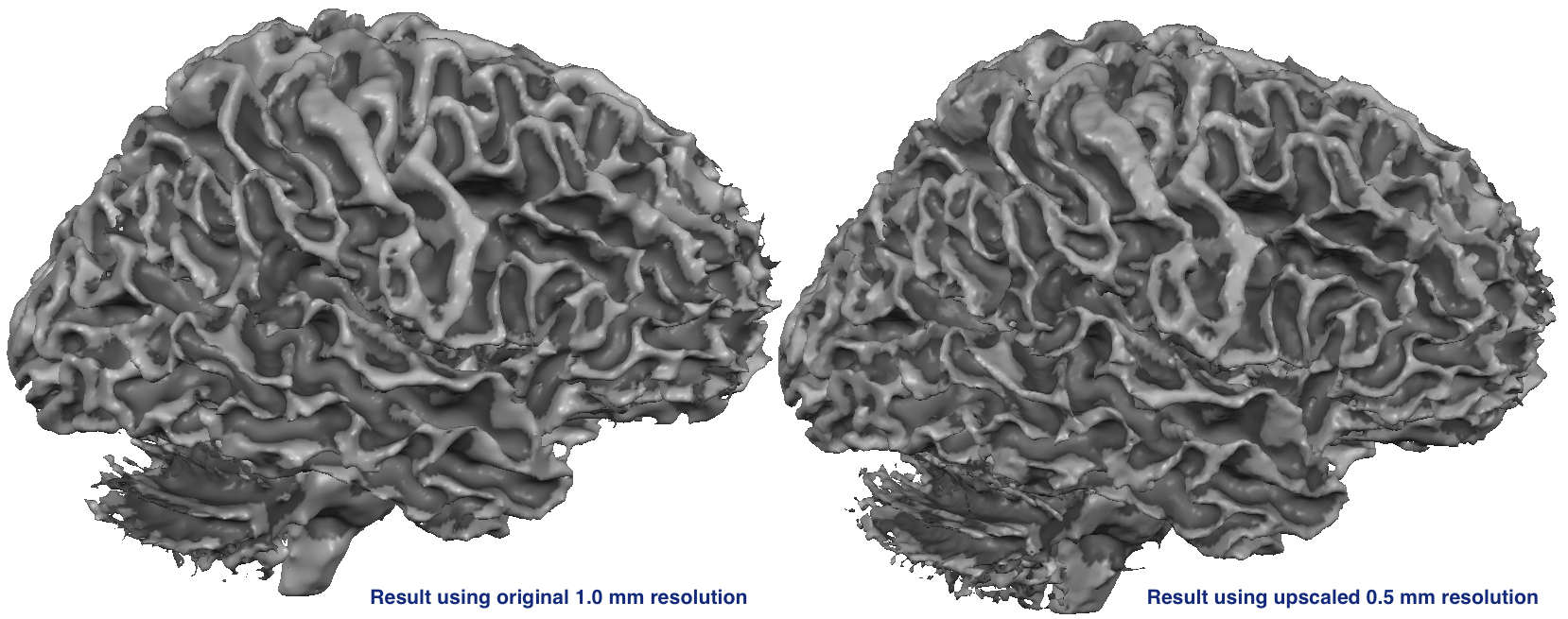BrainVoyager v23.0
Automatic Cortex Segmentation for BBR
For running boundary-based registration (BBR), a cortex mesh is needed that models the white/grey matter boundary of the VMR data set that one wants to align with a functional (or diffusion-weighted, anatomical...) data set. In order to obtain automatically a mesh that serves this function, a special simplified version of the advanced segmentation tools has been made available that results in a whole-cortex mesh that can be directly used for BBR. The BBR segmentation tool does not assume that the VMR is located in normalized (ACPC/TAL/MNI) space, i.e. it can be run directly from a native space VMR after the intensity inhomogeneity correction (IIHC) step. The resulting mesh will not be "perfect", i.e. it will contain subcortical structures and the cerrebellum and it will likely have several topological errors. As long as the mesh reconstructs the white/grey matter boundary in most places, these issues will not have a negative impact on the quality of the subsequently performed BBR alignment due to its high robustness and tolerance to segmentation errors.

The automatic segmentation is started from the Automatic Cortex Segmentation For BBR dialog that can be invoked by clicking the Automatic Cortex Segmentation For BBR item in the Volumes menu. The dialog (see snapshot above) has only a few options that can be used to influence the segmentation pipeline but the default values are usually working well and should only be changed in case of problems. It is recommended to run the operation using the original (sub-millimeter) resolution of the VMR data set. If a VMR data set has a spatial resolution of 1.0 millimeter (spatial resolutions > 1.0 should not be used), one can upscale the data to 0.5 mm using the Scale to 0.5 mm resolution option as is suggested when using the advanced segmentation pipeline. Tests with upscaled 0.5 mm and original 1 mm data sets have shown that for the purpose of BBR application, the upscaled version does not result in better results. The snapshot below shows the resulting mesh when using either the original spatial resolution of 1.0 millimeter (left side, VMR data set from "Objects" example data) versus when using a VMR with an upscaled spatial resolution of 0.5 millimeter (right side). Since the resulting grey/white matter boundary as well as the transformation parameters obtained from BBR do not substantially differ, it is advised to save processing time and to not upscale data sets with a resolution lower than 0.5 millimeter, including even 1.0 millimeter data sets.

Like in the advanced segmentation pipeline segmentation is using global and local region growing and the relative values between grey and white matter can be adjusted as described for the advanced segmentation tools using the GM-WM global cut point field and the GM-WM local cut point field, if desired. In case that the VMR data set has sub-millimeter resolution (or when a VMR with low resolution is upscaled to 0.5 mm resolution), the resulting cortex mesh may have more than a million vertices. In order to reduce the number of vertices, the Decimate mesh to option should be used; the default number of vertices after mesh simplification is set to 300 thousand vertices but this number can be changed in the Decimate mesh to spin box. The mesh decimation function is only executed if the reconstructed mesh has indeed more vertices than specified in this field.
Note that the BBR segmentaiton pipeline results in a whole-cortex segmentation and associated reconstructed mesh, i.e. the left and right hemispheres are not disconnected since this is not necessary (and not desired) for BBR. In case one needs more fine-grained control, one can also use the Advanced Segmentation Tools dialog together with manual cortex segmentation and reconstruction steps. An alternative strategy is, for example, to transform the native space VMR first into ACPC/TAL space, performe (standard or advanced) segmentation in that space and finally transform the reconstructed mesh back into native space.
After the white-matter cortex segmentation pipeline has completed, a mesh is automatically reconstructed and smoothed (and eventually decimated). The mesh is also automatically projected into the VMR that an be used for controlling the segmentation quality. The mesh can be used directly to run BBR for standard fine-tuning FMR-VMR alignment as well as for xx FMR-VTC space.
Copyright © 2023 Rainer Goebel. All rights reserved.